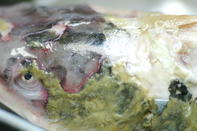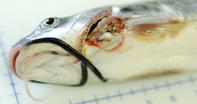The health status of fish is influenced by three factors: fish (host), pathogen (disease-causing agent) and environment (water).

Although disease outbreaks are not common in freshwater fish farming systems (aquaculture), pathogens that can cause illness and disease are always present in the water environment.
Farmers have to maintain a good health status in their fish by ensuring good water quality (environment) and regularly checking for the presence of diseased fish. Very importantly, good health management starts with purchasing healthy fish from registered suppliers.
Causes of Health Problems in Fish Farming
In freshwater fish farming systems, there are a number of reasons why problems with fish health and disease can occur.
This can include infectious diseases (caused by parasites and bacteria), the effect of the environment (poor water quality), poor management practices and any action/event that causes stress.
Every possible measure should be taken to limit stress on the fish. Care should be taken with transport and movement of fish, handling and grading as well as feeding and harvesting of fish.
How to Monitor Fish for Diseases
Monitoring the health and well-being of fish is a routine management task. Visual inspection and monitoring should be done daily when feeding the fish.
A more comprehensive health check should be done monthly and a thorough investigation should take place immediately when a disease situation has been noticed.
Disease monitoring includes the following: Feed response: Are the fish eating less? Behaviour: Any abnormal behaviour should be noted.
Breathing: Are the fish struggling for air? Swimming motion: Are the fish just hanging in the water? Appearance: Check for skin colour, texture and any visible marks or sores.
Water environment: Test for water visibility, oxygen, temperature, pH and ammonia levels
The Importance of Monitoring Disease in Aquaculture?
Prevention is better than cure. Regular monitoring will help identify fish disease problems as soon as they occur while maintaining good water quality (optimum environment) is essential for good health.
It makes economic sense to prevent disease from occurring rather than trying to treat a problem. Firstly, treatments are often expensive (limited range of products for use with fish).
Secondly, disease treatment is also time-consuming and may delay the selling of fish due to the mandatory withdrawal periods. (The withdrawal period is the time the medicine takes to be eliminated from the body to ensure the meat is safe for human consumption.)
Signs of Disease in Fish

Sick fish do not grow that well and will show a poor feed conversion. (A poor feed conversion is when a lot of feed is needed for fish to gain weight).
Check for these common signs of poor health or disease: Loss of appetite. Fish are lethargic, swimming slower or hanging in the water. Abnormal behaviour such as flashing or jumping.
(Flashing is when a fish rubs itself against a surface to get rid of parasites). Change in appearance - colour fades, fish becomes darker, excess mucus. Obvious marks on the body or fins, damage, ulcers or fin rot. Mortality increases (dead fish are found more frequently).
How to Prevent Fish Diseases
Good water quality in aquaculture is essential for good fish health. Clean healthy water will support a good immune response in fish in case of disease occurrence.
Good water quality includes temperature levels between 8 and 20°C, a pH range around neutral (pH 5 to 8), low ammonia levels (lower than 1 mg/litre) and high oxygen levels (higher than 7 mg/L).
By Marinda Louw